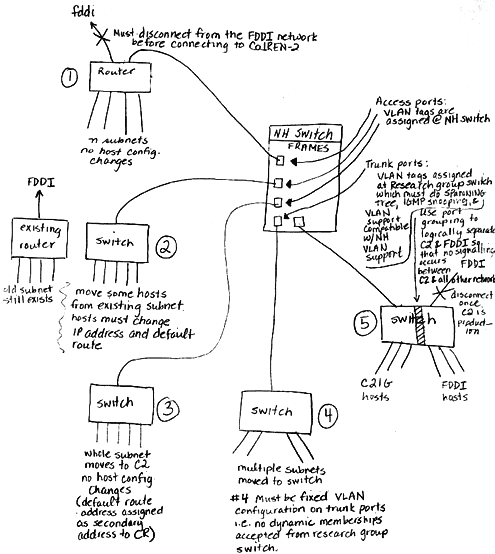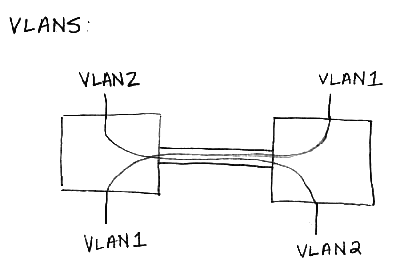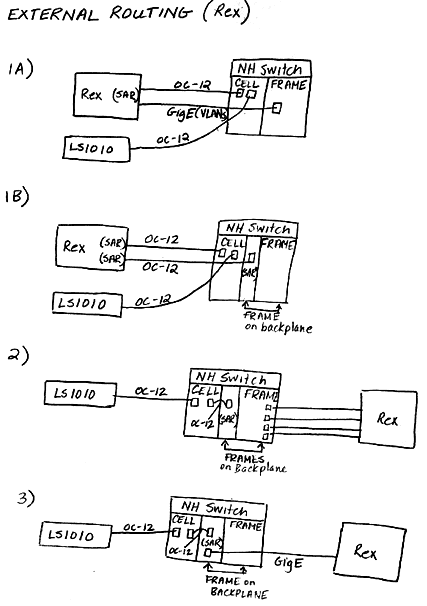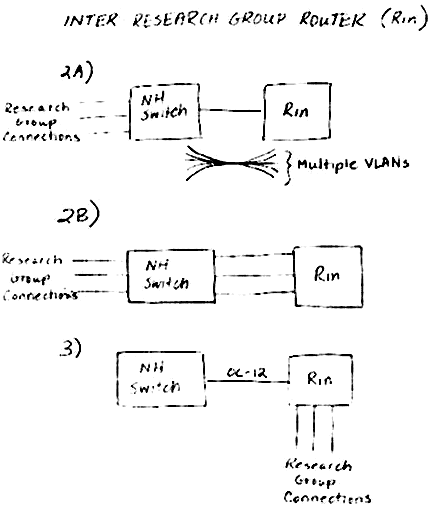Present: Rob Bootsma, Nathan Freitas, Ben Humphrey, Elise Meyer, Larry Murdock,
Rich Prohaska, Kevin Schmidt, and Jason Simpson
Research Group Connection Types
- Alexandria (Library) - Fast Ethernet
(Engr I) - Fast Ethernet
- Arts - Fast Ethernet
- Comp Sci (Multimedia) - Fast Ethernet
(Super Web) - Fast Ethernet
- HEP - Fast Ethernet
- ICESS - Fast Ethernet (via phone call)
- ITP - Fast Ethernet (via email)
We haven't heard from Music – we assume that their default should be OC-3 ATM.
Research Group Fiber
We reviewed how many of the research groups had adequate fiber running from where the CalREN-2 fiber was brought into their building and where their network equipment will be located.
- Alexandria (Library) - OKAY
- Arts - OKAY
- Comp Sci (Multimedia) - Needs to run fiber
(Super Web) - Needs to run fiber
- Alexandria (Engr I) - Needs to run fiber (EM: I'm assuming that
this is the same as the Comp Sci groups)
- HEP - OKAY
- ICESS - OKAY (via phone call)
We don't know the situation for ITP and Music.
There was just a mention that this should be the responsibility of the research groups.
Connecting Switches and Routers
We continued the discussion documented in the previous notes about detailing
the issues involved in connecting switches and routers to the new backbone.
(see diagram below.)
An additional scenario was proposed where a routing switch is still attached and routing to the FDDI backbone, but where it was
possible for the switch to use port groupings to logically separate the ports
so that some could use the FDDI, and some could have a switch access to the
new CalREN-2 backbone. The important factor is that there is no signalling
between the networks. This is indicated in the following diagram as #5.
The group decided that this was technically possible, but we should recommend
against it.
It was asked why you couldn't have scenario #1 (the router connection) also
have a connection to both CalREN-2 and the FDDI. The answer was no, because
routing is based on the destination address, not the source address, so there
wasn't a way to stop the non-CalREN-2 subnets from using the CalREN-2 network
for offcampus destinations.
All switches must do: spanning tree (802.1d), and they also should do IGMP
snooping.

Why Switch Connections?
Here are a variety of reasons proposed by the research groups for why they
should be able to connect via switches:
- Cheaper connection cost for the research group
- Some of the research groups that are going to initially attach to this network are currently connected to the FDDI via a shared departmental router. Since the general thought was that only research groups would initially attach to this network, it doesn't seem fair to make them purchase an additional router.
Switch Support
Switch connections mean that the new backbone must support/provide one of the following:
- Proprietary VLANs
- 802.1Q Standardized VLANs (802.1Q is currently in draft 10)
- A big old router
What do you get with VLANs?
- Broadcast containment
- Protocol containment
- VLAN switch interfaces are cheaper then router interfaces
- Switches can distinguish individual VLANs over trunk links and can multiplex and de-multiplex over a single physical link (see diagram below.)

None of the research groups wanted VLANs for anything more than a way to allow them to connect to the backbone via switches (i.e., provide inter-research group
routing). This can also be provided by having the switch connections plug into a central router instead of a backbone switch. It was mentioned that VLANs might be a mechanism to provide Class of Service (CoS). This is not really a feature of VLANs. CoS is based on vendor-specific typing of priorities, and VLANs could be one of the criteria that packets are classified by for CoS.
What We Mean by Centralized Routing
There are really two different routing issues that need to be addressed. One is external routing issues, i.e., what routing needs to occur in order to be able to send packets to an off-campus site. The other is inter-research or internal routing issues.
External Routing (Rex)
Requirements:
- Must deal with OC-12 coming from off campus.
- Must be able to Map PVC's to unique logical interfaces for routing (At a minimum we think there will be at least two PVCs, vBNS and CalREN-2, in time there will probably also be one for UCNET.)
- Must do BGP
- Must have good performance
- May need VLANs (it depends on which Rex scenario is chosen.)
Our current external campus routing is done by sbgty, but it appears that
the soonest that sbgty would be made available, if at all, for use on CalREN-2
wouldn't be until after UCNET is converted over to CalREN-2 (estimated
December 31, 1998.) The group noted that it might not be a good idea to
use sbgty even then because it was important for the campus to be able to
make local configuration changes, and that might not be possible on UCOP
managed equipment.
The possible options for Rex are:
- The off-campus OC-12 PVCs are mapped to Rex, and Rex can map each PVC
into a logical interface. There are two possible ways to do this (see
diagram #1A and #1B below). In 1A) the SARing is only done by Rex, and ReX must
be able to do VLANs. In 1B) SARing occurs between the two Rex interfaces
and on the switch, but ReX doesn't need to do VLANs.
- The off-campus OC-12 PVCs are mapped to the switch. Rex doesn't do VLANs.
The switch breaks out
the PVCs into separate physical interfaces and these are connected into
separate physical interfaces on Rex (e.g. Rex has one i/f per research
group and PVC). SARing is done by the switch. (See diagram #2 below).
- The off-campus OC-12 PVCs are mapped to the switch. Rex does VLANs.
The switch maps the PVCs into individual VLANs and the VLANs share one
physical link connecting the switch to Rex. SARing is done by the switch.
(See diagram #3 below.)

Inter-Research Group Routing (Rin)
Requirements:
- Talk to Rex
- Route between research groups
- OSPF
- RIP (No one really wanted to include RIP, but there was thought that we might not be able to exclude it at this point.)
- Adequate performance
This is currently being accomplished on the FDDI by everyone connecting to the backbone via routers.
The possible options for Rin are:
- A routing switch
- Using a separate router (Rin):
- A. Rin supports VLANs, so multiple VLANs can use 1 physical interface (see diagram #2A below.)
- B. Rin doesn't do VLANs, so each VLAN must have its own physical interface. The connection between Rin and the switch must be OC-12 ATM. (see diagram #2B below.)
- If VLANs are not to be supported on the backbone, then Rin is a big router and switch connected research groups must connect to Rin instead of the backbone switch, and Rin must have an ATM connection to the backbone switch. (see diagram #3 below.)

Backbone Support
We started to discuss what level of support would be desired for this backbone. The general consensus was that it was desired that the backbone have 7 by 24 support, since the research groups had similar support, and the offcampus connection had similar support.
Discussion
That is the end of the meeting minutes. Now for some discussion that occurred
after the meeting that we should think about.
The question was asked how the RFP-selected FSB fits into the Rex and Rin discussion and at the meeting I said that we had to find out a bit more about the FSB to know. Here's what we've determined so far.
-
We don't know of a router that does VLANs using the proprietary VLAN method used by the FSB.
-
The FSB can map PVCs into individual VLANs (we don't know the SARing performance for this, and we don't know if it is done in such a way that an offcampus external router can route the IP data.)
-
Regarding Rex:
- If we can find a router that does support 802.1Q VLANs, then we can do Rex #1A or Rex #3.
- If we can't find a router that does 802.1Q VLANs then we can only do Rex #1B or Rex #2.
-
Regarding Rin:
- The FSB is not a routing switch, so option #1 is not possible.
- If we can find a router that does support 802.1Q VLANs, then we can do Rin #2A.
- If we can't find a router that does 802.1Q VLANs then we can only do Rin #3 or Rin #2B.
-
If we wanted to combine Rex and Rin functionality into one router we would want:
- High performance (either OC-12 or GigE or both)
- BGP
- 802.1Q VLANs
-
To address Kevin Almeroth's multicast issues:
- DVMRP (prefer PIM, also require tunnel & pruning support)
- MBGP (Rex only)
We must have Rex functionality in order for CalREN-2 to work, but do we have to have Rin functionality?
-
We only have to have Rin functionality in order to allow research groups to
connect to the backbone via switches. It should be cheaper for the campus
as a whole to buy one Rin instead of having each research group buy their
own routers, and also the maintenance and operation of a central Rin should
be less. Supporting VLANs and centralized routing is also a good
direction to go for a next generation backbone. BUT, the bottom line is that
we might not be able to afford to pay for that functionality now out of the
CalREN-2 budget. If that is the case, where do we go from here?
-
If we decide that we don't want to support switch connections by research groups
then research groups connect with routers, and we would have Rex #1A without
VLANs.
Back to Main CalREN-2 Page
EMM

